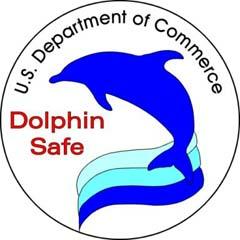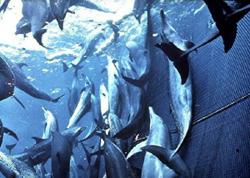|
The New Year's Eve finding cleared the way for
tuna caught under the terms of a binding
multilateral environmental agreement, particularly
in waters off the coast of Mexico, to be imported
into the United States with the dolphin safe label,
so long as no dolphins are injured or killed during
the set in which the tuna are caught.
"One of our main goals is to reduce dolphin deaths and
to conserve living marine resources, while at the same
time maintaining the sustainability of the Eastern
Tropical Pacific tuna fishery under the international
agreement," said NMFS director Bill Hogarth.
"This agreement has reduced dolphin mortality from
hundreds of thousands of dolphins to
approximately 2,000 dolphins per year."
In 1991, NMFS implemented the "dolphin safe" labeling system as a way of reducing dolphin deaths due to tuna fishing. Under the initial label criteria, tuna harvested in the Eastern Tropical Pacific could be labeled "dolphin safe" only if no nets were intentionally set on dolphins during the fishing trip.
Under the December 31 decision, the criteria have been changed so that tuna harvested in the Eastern Tropical Pacific by large purse seine vessels can be labeled dolphin safe even if dolphins are encircled, so long as an on board observer certifies that no dolphins are killed or seriously injured during the set in which the tuna were caught.
NMFS Director Bill Hogarth during a wetlands
restoration day in Baltimore Harbor, Maryland.
(Photo by Bill Folsom, courtesy NMFS)
"The dolphin safe label was developed as a way to help protect and conserve dolphins," said Hogarth. "With this decision, Americans can continue to have confidence that when they purchase tuna with the dolphin safe label that dolphins are being protected."
But conservation groups warn that the relaxed requirements for dolphin safe labeling could lead to the deaths of thousands more dolphins each year.
"The whole point of the 'dolphin safe' label is to give consumers a choice of tuna that wasn't caught by netting dolphins," said William Snape, vice president for law and litigation at Defenders of Wildlife, one of several groups planning to challenge the NMFS decision in court. "We have great confidence that the courts will strike down this blatantly illegal decision," Snape added.
In the 1950s, fishers discovered that yellowfin tuna in the Eastern Tropical Pacific could be found beneath schools of dolphin. For years after the discovery, the predominant tuna fishing methods in the region involved encircling schools of dolphins with fishing nets to trap the tuna concentrated below.
Hundreds of thousands of dolphins died because of this fishing method. Under the International Dolphin Conservation Program (IDCP), fishers were required to change their purse seine fishing methods, and since the 1980s, confirmed dolphin mortalities have dropped to about 2,000 per year.
|


